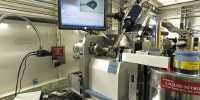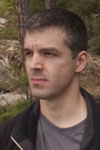
6 Billion electron-volts and 1 tiny crystal
Beamline 14, ESRF Synchrotron, Grenoble, France
September 25, 2005 - 10:30 AM local time
© 2005 Mark Banas, All Rights Reserved.
This panorama was shot inside one of the lead-lined "experiment cabins" that lay at tangents to the main synchrotron ring. The long metal tube extending to the right is what carries a portion of the circulating beam into the room, and specific equipment at this station allows that beam to be "tuned" to various wavelengths. At the end of the beam (and shown magnified on the screen above it) sits a frozen crystal of purified protein that will be exposed to the high energy beam to determine the atomic structure of the individual protein itself. Across from this, on the left side, is the large electron detector which functions as a giant digital camera to capture the X-ray diffraction patterns after they pass through the crystal.
Because this room is exposed to the X-ray beam during experiments, most of the equipment you see is designed to be operated by remote control once the experiment is set up, and safety systems insure that no humans are inside when the shutter for the beam is opened. This panorama was taken while the beam was off, so the door is seen open, and much of the equipment is being taken offline after weeks of non-stop work.
If you want to imagine the magnification of this "super microscope," zoom in on the tiny crystal being examined (a white speck where the metal tubes converge) and then use the Google Earth link (below) to "zoom way out" and see the synchrotron ring itself surrounded by the Vercors and Chartreuse mountains.
Special thanks to Dr. Martin Walsh and Dr. Max Nanao of the BM14 CRG beamline for this rare view of a working experiment cabin.
The high-security campus for the synchrotron lies at the confluence of the Drac and Isere rivers in the southeast corner of France, at the foothills of the French Alps. ("Foothills" here can mean 2400 meters tall!)
The electrons emitted by the main electron gun are accelerated to reach an energy level of 6 billion electron-volts (6 GeV), and the power to do all of this is provided by a dedicated power plant on the campus.
The main synchrotron is a large (844 meters in circumference) storage ring where electrons circulate in a vacuum, at a constant energy, before being diverted into some of the 40 beamlines.
600 people work at the ESRF to maintain the facility, assist visiting researchers, develop new technologies, and carry out their own experiments.
The Agnos panoramic head and my camera take up very little room when rotating, so the 3 photos were simply taken with a timer (so no shadows would be visible) and a pause to rotate the head between each shot.
The images were stitched together with PTMac and blended with Enblend, with some minor retouching to the seams. The hardest part was cloning the tripod out of the photographs since it spread across most of the table - and I forgot to take a "down" shot! Thank heaven for Photoshop...


 Tap or click the zoom icon in the bottom right corner of the picture to switch between in-page and fullscreen view
Tap or click the zoom icon in the bottom right corner of the picture to switch between in-page and fullscreen view